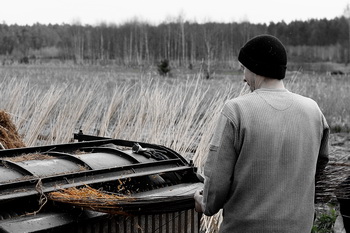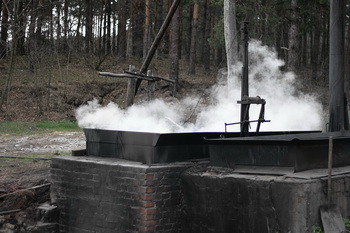Processing of the willow
Wickerwork
Processing of the willow
 When the willow reaches the proper height and the season indicates that it is time for the harvest, the process of reaping the wicker begins. The wicker is cut down the moment the leaves fall off, when it is completely lignified; in other words, when it is in a state of vegetative dormancy that will last until early spring. One must keep in mind, however, that in spring the vegetation process will begin anew. The wicker is either reaped manually, with a billhook, or by means of a special mower that is properly outfitted for the job. It is best to reap the wicker just before the further processing, so as not to waste time on the drying. After the wicker is cut down, it is tied into bundles and placed on the field in an upright position. Depending on its further fate, it is either treated further or prepared to be stored away for the winter.
When the willow reaches the proper height and the season indicates that it is time for the harvest, the process of reaping the wicker begins. The wicker is cut down the moment the leaves fall off, when it is completely lignified; in other words, when it is in a state of vegetative dormancy that will last until early spring. One must keep in mind, however, that in spring the vegetation process will begin anew. The wicker is either reaped manually, with a billhook, or by means of a special mower that is properly outfitted for the job. It is best to reap the wicker just before the further processing, so as not to waste time on the drying. After the wicker is cut down, it is tied into bundles and placed on the field in an upright position. Depending on its further fate, it is either treated further or prepared to be stored away for the winter.
There exist four methods of decorticating the willow: keeping in water, holding, boiling, also called “brewing,” and steaming. Keeping in water is done in natural streams, ponds, lakes, pools or tributaries, or in artificial basins made of concrete with a few centimeters of sand covering the bottom. The place must be well-lit and breezy. The depth of the water should be around 15-20 cm. Keeping in water begins in early spring and lasts from three to six weeks depending on the weather and type of wicker. Once the wicker is “awakened”, that is, once leaves appear on the rods, decortication should begin. In this way we receive white willow wicker, which is then dried to protect it from rain and sun. In winter or early spring, the bundles of wicker are placed in the basin, most often in a rectangular pattern in groups of 12 or 16, separated by horizontal sticks to prevent them from falling over. In spring, the sunlight causes the growth of offshoots; when the first leaves appear, generally in mid-May, the offshoots are checked to see if they can be stripped, as well. If so, the material is then decorticated. Due to the quick growth of wood and the worsening of the rods’ appearance, the process of keeping in water cannot be delayed. The seasonality of, and short period of time to go through with the keeping in water causes problems to appear in the decortication of the wicker willow and technical defects in the wicker itself.
 Holding is also a physiological method. It is similar to keeping in water, except that it occurs in a closed container equipped with low basins and heated to a temperature of 25º C. The use of this method allows white wicker to be (received) four or five times throughout the course of winter. In this way, certain shortcomings of the keeping in water – such as its seasonality, or dependence on weather conditions – are eliminated. Unfortunately, other problems remain, which generate considerable costs. For this reason, willow harvesters are beginning to abandon the keeping method in practice. The “boiling” method is widely used, on the other hand. This type of process belongs to the group of hydrothermal methods. Here, the ease with which the bark can be separated from the wood of the offshoot is achieved with the help of hydrolysis and the dissolution of the pectin contained in the cell membrane, not – as was the case with the previous methods – by stimulating the cambium to physiological activity. The process of denaturation and a change in the qualities of the cohesive substances occurs after the willow is boiled in special tubs, where the water is made to boil with the help of steam from the central heating system or a hearth. The time of the stripping is matched to the needs of the given type of wicker and dependent on the method of stripping used – manual, or mechanical. After the boiling is finished, the wicker is moved to basins filled with cold water to cool, where it will be stored until the time of its transfer to the stripping plant.
Holding is also a physiological method. It is similar to keeping in water, except that it occurs in a closed container equipped with low basins and heated to a temperature of 25º C. The use of this method allows white wicker to be (received) four or five times throughout the course of winter. In this way, certain shortcomings of the keeping in water – such as its seasonality, or dependence on weather conditions – are eliminated. Unfortunately, other problems remain, which generate considerable costs. For this reason, willow harvesters are beginning to abandon the keeping method in practice. The “boiling” method is widely used, on the other hand. This type of process belongs to the group of hydrothermal methods. Here, the ease with which the bark can be separated from the wood of the offshoot is achieved with the help of hydrolysis and the dissolution of the pectin contained in the cell membrane, not – as was the case with the previous methods – by stimulating the cambium to physiological activity. The process of denaturation and a change in the qualities of the cohesive substances occurs after the willow is boiled in special tubs, where the water is made to boil with the help of steam from the central heating system or a hearth. The time of the stripping is matched to the needs of the given type of wicker and dependent on the method of stripping used – manual, or mechanical. After the boiling is finished, the wicker is moved to basins filled with cold water to cool, where it will be stored until the time of its transfer to the stripping plant.
“Steaming” of the wicker is a different hydrothermal method. This action consists in steaming the willow with water vapor in special boilers, under the pressure of two or three standard atmospheres. This allows the wicker to be ready for stripping within 15 to 20 minutes. The downside to this method is that such wicker is able to be stripped only when hot, so for a very short time. This creates organizational problems and is tied to a certain threat to the workers’ health. The next step is the drying of the stripped wicker, though some prefer to do the weaving while the wicker is wet, since it is more flexible. When the wicker dries it is gathered and tied in 5 to 10 kg bundles, depending on the size.